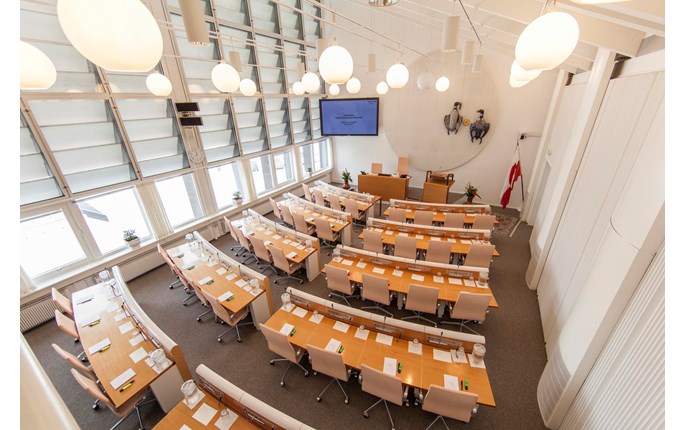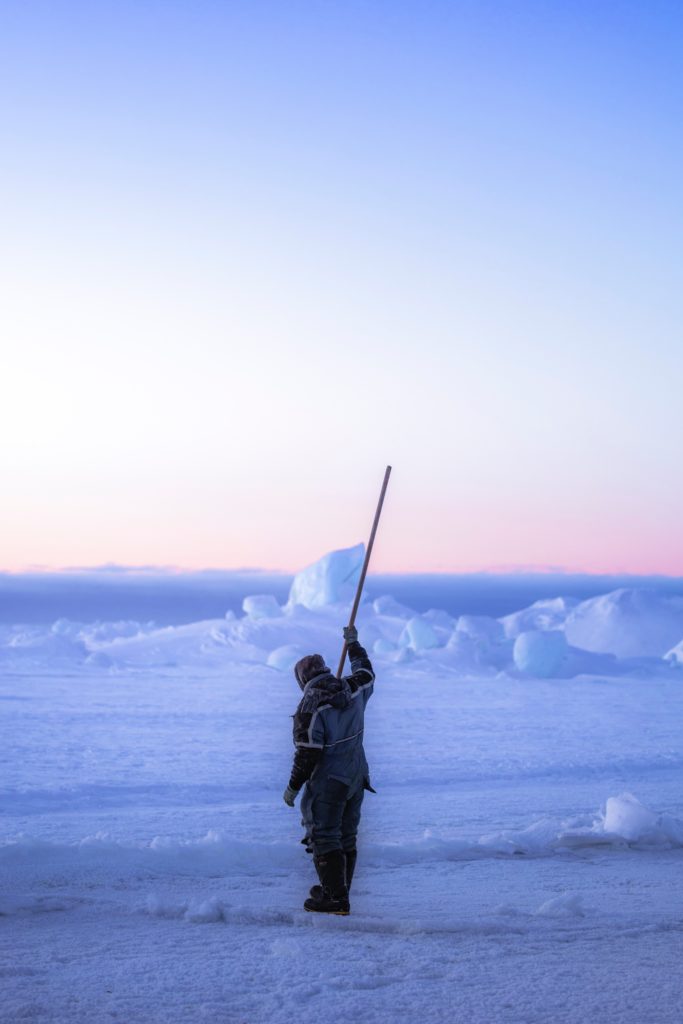Greenland drafts constitution for its ultimate independence
Greenland’s first draft constitution calls for a Greenlandic republic, recognition of its Inuit heritage, and a farewell to the Danish monarchy.

In November 2016, a jubilant majority of the Inatsisartut, Greenland’s parliament, kick-started the drafting of a constitution for a future, independent Greenland. Lars-Emil Johansen, the parliamentary chairman, celebrated the event by singing an upbeat political hymn with members of his party in chambers below the parliament.
The creation of a constitutional committee was regarded as yet another important stepping stone in the divide separating present-day Greenland, which is still a part of the Danish kingdom, from an ultimately free, sovereign Greenlandic state. To the majority of Greenland’s legislators, the drafting of a constitution followed naturally from the 1979 Greenland Home Rule agreement, which was further expanded in 2009.
Lars-Emil Johansen, now a pensioner, was a key political figure in 1979. He believes that independence has inched a small, but significant bit closer with the draft constitution that was published on April 28th, after more than six years of proceedings:
“Yes, independence has come one step closer. The draft will now be debated in parliament, but also among the people. In the end it will be subjected to a referendum,” he told me.
Collectivity
The draft, however, is not to be passed into law by parliament just now. According to the Self Rule arrangements with Denmark adopted in 2009, Greenland is “free to initiate a preparatory constitutional process.” But if the leadership in Nuuk should vote on and pass into law any active alternative to the Danish constitution it would be regarded by the government in Copenhagen as a first step toward secession. This would endanger the annual Danish block grant to Greenland, which presently pays for just over half the public expenditures in Greenland.

According to the Danish government, the Danish Kingdom cannot harbor more than one constitution. This is a long cemented ground rule, fiercely defended by the government’s legal experts: one which the Faroe Islands, also a part of the Danish Kingdom, came upon hard some twelve years ago when the Faroese were drafting their constitution.
The Greenlandic draft is most of all meant to focus public discourse in Greenland on the fundamentals of what kind of state Greenland will become, should the people decide to establish their own sovereign state.
In principle, the draft is to be discussed by all interested parties along Greenland’s vast, inhabited coastline, where its 57,000 inhabitants are scattered in more than 70 settlements. According to the loosely talked about plan, the draft will then be amended and readied for when the day Greenland secedes from Denmark. But no one knows if and when this will actually happen – even as the majority of the electorate is believed to share this vision today.
The draft, however, could also take on more immediate importance, as Sara Olsvig tells me. An advising expert to the drafting committee, Sara Olsvig is a former leader of Inuit Ataqatigiit, Greenland’s main governing party, and is presently Chair of the Inuit Circumpolar Council. She hopes that the draft constitution will influence also the current legislative process in Greenland:
“It is actually too bad that we are only engaged in this process now. We have passed legislation for ourselves for many years without the benefit of a legal framework for our work, chosen by ourselves. Important reforms are still on the table, including reforms of our fisheries, so it is quite necessary that we engage in discussion about, for instance, our relation with nature, what collective ownership of our resources means, and what fundamental human rights should be protected in Greenland,” she says.
No king in a future Greenland
At the ceremony in Nuuk when the draft constitution was formally handed over to the chairman of Greenland’s parliament, a traditional drum dance was performed and – according to media reports – several in the audience shed a tear or two.
According to the draft now at hand, a future independent Greenland would be a parliamentary republic. It would not be presided over by a powerful president elected through separate procedures as in the US or France but with the chairman of
Naalakkersuisut, Greenland’s government, as its Head of State.
The draft constitution accords no role to the Danish Royal House. After more than 300 years with a Danish king or queen ruling over Greenland, the drafting commission has chosen not to recommend a continuation of the monarchy’s hold when or if Greenland gains independence.
In Denmark, this has gained some attention. Although there has been no comment from the Danish royal house, Rasmus Jarlov, a conservative member of the Greenland Committee of the Danish parliament, finds the potential absence of the royal family in a future Greenland rather embittering:
“It is sad. It is a clear goodbye to anything Danish. I also note that the Danish language is accorded no role. I hope that there is no widespread support for this, but it is not something over which we have any influence,” he told me.
Another member of parliament in Copenhagen has asked the Danish prime minister Mette Frederiksen if Denmark will continue the annual financial subsidies to a future Greenland with no Danish queen or king. Mette Frederiksen has refused to enter into the discussion and instead referred to the law on Greenland’s Self Rule, which specifies that secession from Denmark will, if it happens, be preceded by negotiations between Greenland and Denmark.
Free association
In their draft constitution, the authors make ample room for a potential new bond between a future independent Greenland and Denmark, if a such connection is desired. The drafters have been careful to provide an option for a partial surrender of sovereignty to accommodate so-called ”free association”. In that case, an independent Greenland would enter into a new union with Denmark or another larger state and call upon support and assistance in areas where independent Greenland would not yet have the full capacity — such as in defense, health, monetary matters, embassies abroad, and so forth.
Free association is recognized by the United Nations as an acceptable governance form and has been adopted by a small number of independent island states in the Pacific that have chosen to be freely associated with either New Zealand or the US. Free association as a model for the future has been high on the political agenda in Nuuk for decades but has not yet entered the political discourse in Denmark in any substantial way.
Inuit-strength
Greenland’s unique character is addressed in the preamble to the draft constitution (my translation as the draft constitution has not been officially translated into English):
“The Greenlandic people are part of nature. We must protect nature, its ecosystems, biodiversity and all its life forms. We live from and with nature which is an inviolate principle for a sustainable society in the future”, the draft reads.
Greenland’s age-old embrace of collectivity is also underpinned:
“Greenland is based on collective rights and the principle that common ownership of all our land, sea and resources is inalterable,” the draft reads.
It is not possible to buy land in Greenland, and as Sara Olsvig implies, there may in the future also be more emphasis on a more collective approach to wealth generated from fish, shrimp, and other seafood in Greenlad’s vast waters.

The question of identity and ethnic heritage is also carefully addressed; these are matters that have often been divisive in Greenland, most recently, a proposed Inuit register has caused much debate. The draft constitution spells out that:
“Inuit are the indigenous people of our land. From this we derive our cultural uniqueness, our history, our heritage and our strength. This must never be forgotten and must be praised, considered and protected at all times”.
Yet in the following paragraph people of other origins are also embraced:
“The Greenlandic society is a multifaceted democracy, where the inaliable rights, dignity
and safety must be protected. We recognize all Greenlandic citizens as equal under
this constitution.”
Sara Olsvig believes a balance has been found:
“To me it is not dangerous that we identify ourselves as Inuit, while there are also other ways of defining one self. We place ourselves in the part of humanity identified as indegnous people and we incorporate a corresponding world view reflecting that we are Inuit. I have no doubt that this is still identifying our society,” she says.
“At the same time we clearly state that it’s perfectly possible to be a Greenlander without being Inuk. A modern Greenlandic state we will adhere to human rights with full respect for minorities. Most people will be Inuit, but we want a society where all have the same rights,” she says.
The protection of minorities is clearly stipulated in the paragraphs of the draft
constitution along with other standard mainstays of a democratic state under the rule
of law: separation of powers, the freedom of speech, assembly, and religion.
Unnecessary
Critics, including Greenland’s liberal party Atassut, have deemed the drafting of a constitution unnecessarily expensive and not needed. Atassut would like for the current power-sharing arrangement with Denmark to continue and withdrew from the drafting commission in 2021.
Pele Broberg, who is chairman of the Naleraq party, is an outspoken advocate for secession. On the day of its entry into the public domain, Broberg dubbed the draft constitution “stillborn”. He explained that he would have liked better a draft constitution written by experts and not by elected politicians. In Broberg’s view, many Greenlandic politicians are far too willing to postpone secession from Denmark.
In the course of its work, the constitutional commission, which has now been dissolved, was marred by frequent shifts of members, politicizing, and petty controversies. None of the seven initial members crossed the finish line. In 2022, after only four months at the helm, Kuupik Kleist, a former Premier of Greenland, resigned as chairman citing frustration over the lack of progress. Meanwhile, Naalakkersuisut — Greenland’s government — initiated a probe into the commission’s financial management, which has drawn much media attention.
In late 2022, the head of Naalakkersuisut, Muté B. Egede, called a halt to the drafting process altogether. The constitutional commission was asked to finalize its work and its budget was not renewed for 2023. In the draft, a shortage of time is cited as an explanation for why the commission’s deliberations on a future judicial system were never completed.
Martin Breum is a Danish journalist and author specializing in Arctic affairs. He is
a frequent contributor to ArcticToday.